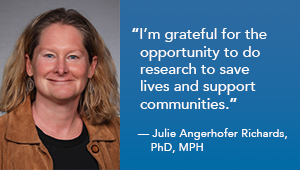Understanding adoption of Lock to Live, a decision aid supporting suicide prevention

KPWHRI research finds ways to increase use of a firearm safety tool
Previous research has shown that Lock to Live (L2L), a web-based aid to help people make decisions about firearm storage, is feasible for use in a health care setting. But very little information was previously available about how best to routinely use it during health care visits. Now, new research led by Julie Angerhofer Richards, PhD, has found that understanding the value of the tool from users’ perspectives was vital for increasing adoption at Kaiser Permanente Washington.
The study evaluated the use of L2L during mental health and primary care visits over 2 years. Adoption rates went from less than 1% to 29% among mental health specialty providers, and from 2% to 48% among primary care providers.
L2L was developed in collaboration with clinicians, firearm owners, and people with lived experiences with suicidality. Firearms are the most common way that people die by suicide, and people who have access to firearms have a higher suicide risk. L2L helps people make decisions about temporarily reducing access to firearms and other potentially dangerous things like prescription medications. It helps people think through storage considerations, such as types of storage, costs of storage, and background check requirements, with a goal of encouraging solutions that are consistent with the users’ values and preferences.
Kaiser Permanente Washington, which provided care to about 700,000 people across Washington state at the time the study began, uses a template in the electronic health record to help clinicians engage patients at risk of suicide in collaborative safety planning. L2L was originally shared with clinicians as an independent resource, but it was later added to the safety planning template (at the suggestion of clinicians) and researchers saw a significant uptick in use of the tool.
“This finding really emphasizes the importance of making it easy to use new resources like this one,” Richards said. “Minimizing the need by clinicians to remember when to introduce Lock to Live was the biggest driver of its adoption during the study.”
The researchers conducted qualitative interviews with clinicians responsible for safety plans and patients with experience receiving mental health care.
Themes that emerged during the patient interviews focused on caring, compassion, nonjudgment, and respect for autonomy. Patients supported having an open conversation about firearms, understanding what to expect from L2L, and addressing privacy concerns.
“Our findings will help support implementation of L2L in health care organizations nationwide,” said Richards, “and broad implementation will make it possible for us to evaluate the effectiveness of L2L for supporting suicide prevention.” The researchers also pointed out that the L2L implementation supported all 6 aims of health care quality outlined by the Institute of Medicine: safe, effective, patient-centered, timely, efficient, and equitable.
The study was funded by Kaiser Permanente’s Office of Community Health and Center for Gun Violence Research and Education, as part of its Firearm Injury Prevention Program, and the Centers for Disease Control and Prevention.
Other KPWHRI coauthors on the study are Elena Kuo, MPH, PhD; Christine Stewart, PhD; and Gregory Simon, MD, MPH.
Free locking devices
Richards’ research on suicide prevention, particularly firearm suicide prevention, has also supported a new program at Kaiser Permanente Washington to distribute free cable locks for safely storing firearms in the home.
As of June 17, any Kaiser Permanente Washington member (or staff member) can receive a free locking device, with support from the Kaiser Permanente Center for Gun Violence Research and Education.
Richards works with Kaiser Permanente Washington leaders on this project, including pediatricians Alexsandra Greer Phillips, MD, MD, and Harbir Juj, MD, and Administer of Clinical Operations Rebecca Parrish, LICSW. Greer worked with Jennifer Halverson Kuehn at the Tacoma-Pierce County Health Department to make firearm lock boxes available to all patients receiving care from Kaiser Permanente clinics in Pierce County beginning in 2023. The Kaiser Permanente Washington Health Equity Action Team also sponsored a forum on this topic titled “Gun Violence, Health, and our Collective Responsibility.”
By Amelia Apfel
News

Kaiser Permanente expands gun violence prevention work
Equity-focused research by Julie Angerhofer Richards, PhD, MPH, is among the work supported by $3.2 million.
Suicide prevention

Most mental health patients answer firearm question
Study shows patients will usually answer a question about firearm access, providing key information for suicide prevention.
Research

Asking about firearm access can normalize and support dialogue for patients
Findings provide roadmap for addressing barriers and improving suicide prevention.



